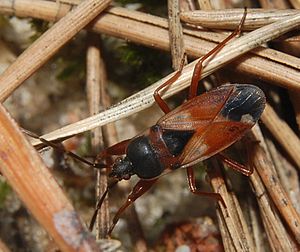Eremocoris abietis
| Eremocoris abietis | ||||||||||||
|---|---|---|---|---|---|---|---|---|---|---|---|---|

Eremocoris abietis |
||||||||||||
| Systematics | ||||||||||||
|
||||||||||||
| Scientific name | ||||||||||||
| Eremocoris abietis | ||||||||||||
| ( Linnaeus , 1758) |
Eremocoris abietis is a bug fromthe Rhyparochromidae family .
features
The bugs are 5.9 to 7.2 millimeters long. Like all species of the genus Eremocoris, they have reddish-brown forewings that bear a pair of semicircular white spots on the membrane adjacent to the Cuneus . Eremocoris abietis has one large and several small thorns on the thighs ( femora ) of the front legs. The hair on the posterior rails ( tibia ) is shorter than the width of the rails. In the similar Eremocoris fenestratus , they are roughly the same length as they are wide. Usually the wings of the adults are shortened, only rarely can one also find flightable, macroptere animals.
distribution and habitat
The species is widespread in Europe from the far north to the Mediterranean. In the east the distribution area extends to Siberia and parts of Central Asia. The species is particularly common in Scandinavia, but is also found everywhere in Central Europe. They can also be found in the higher altitudes of the low mountain ranges and in the Alps up to 1000 to 1300 meters above sea level, occasionally over 2000 meters. The species colonizes dry forests and their edges, preferably on sandy soils.
Way of life
The animals live mainly in loosely grown coniferous stands with pine ( Pinus ), Larch ( Larix ) and juniper ( Juniperus ), but they are also found in the acidic leaf litter under blueberries ( Vaccinium ), heather ( Calluna vulgaris ), crowberry ( Empetrum ) and similar dwarf shrubs. The bugs are often found in places where wood ants ( Formica ) and, more rarely, Ross ants ( Camponotus ) live. One can even find nymphs and adults in the ant nests, where they are tolerated and probably also feed on prey and the ant brood in a predatory manner. However, ants are not required for the development of bugs. They can often be found on the ground on cones of conifers, where they suckle their seeds. The adults overwinter under loose bark and especially in dry coniferous litter or in anthills. In the latter one can occasionally also find overwintering nymphs. There is usually one generation per year, with the new generation adults appearing from around August. The development in ant nests is apparently acyclic, so that there can be more than one generation per year.
supporting documents
Individual evidence
- ↑ a b c d guard: bugs , Vol 3, p 109ff.
- ↑ Eremocoris abietis. British Bugs, accessed December 29, 2013 .
literature
- Ekkehard Wachmann , Albert Melber, Jürgen Deckert: Bugs. Volume 3: Pentatomomorpha I: Aradoidea (bark bugs), Lygaeoidea (ground bugs, etc.), Pyrrhocoroidea (fire bugs) and Coreoidea (edge bugs, etc.). (= The animal world of Germany and the adjacent parts of the sea according to their characteristics and their way of life . 78th part). Goecke & Evers, Keltern 2007, ISBN 978-3-937783-29-1 .
Web links
- Eremocoris abietis at Fauna Europaea. Retrieved December 29, 2013
